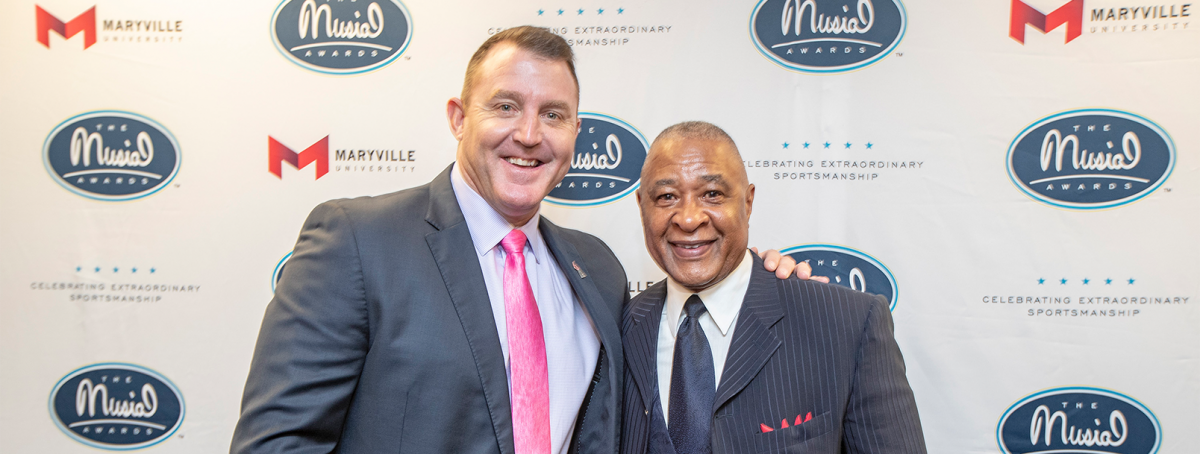
Jim Thome
When you do your job well enough to be ranked among the top half-dozen men in the history of your profession, it’s almost impossible to blend in. Yet both Stan Musial and Jim Thome managed that trick in baseball, raising “blending in” to an art form and serving as the ultimate team player through a daily display of humility, grace, generosity and integrity. They share a few other traits, too. Each played 22 seasons. Each is beloved in the cities where they played and by those in the game. Teammate Michael Cuddyer called Jim “the nicest, gentlest, kindest guy you will ever meet to everything except the baseball.”
Throughout his career, Jim pummeled the ball. He is one of only five players in big league history with at least 500 home runs, 1,500 runs scored, 1,600 RBIs and 1,700 walks. The others: Barry Bonds, Mel Ott, Babe Ruth and Ted Williams. His 13 walk-off home runs are more than any other player in major league baseball – one more than Stan himself. For parts of 13 seasons, Jim hid in plain sight with the Cleveland Indians. He had flashier teammates, like volatile slugger Albert Belle and speedy Kenny Lofton, yet none was as solid and dependable. At 6-4 and 240 (give or take), he was a rock at third base.
And he took one for the team after the 1996 season, when Cleveland won 99 games and the AL Central title but lost in the Division Series. General manager John Hart thought the missing piece could be Matt Williams. A trade for Williams, a third baseman, meant Jim would have to move. The logical spot was first base, except that he had never played the position. When Hart asked, though, Jim didn’t hesitate. “If you think this makes us a better team, I’ll be glad to do it,” he told the Akron Beacon Journal. To learn the position, Jim reported to spring training early, among the first to arrive and the last to leave every day. He and the Indians were rewarded. Jim hit 40 homers for the first of six times, drove in 102 runs, led the majors in walks and made the first of five All-Star appearances, while the Indians advanced to the World Series. Sounds a lot like 1946, when the Cardinals moved Stan from the outfield to first. He transitioned to the infield by leading the league in batting, hits, singles, doubles and triples, and the Cardinals to the World Series title.
In an era when performance enhancing substances boosted the stats of many of his rivals, Jim’s prolific power numbers were never called into question. “My father would kill me if I ever did anything like that,” he said. Jim never forgot family and has nurtured his roots in Peoria, Ill. At the suggestion of his mom, Joyce, he started a benefit for Children’s Hospital of Illinois in 1994. The event was renamed in her memory after her death in 2005 and has raised more than $1.7 million. When tornadoes ravaged towns around Peoria in 2013, Jim stepped up to donate $100,000. As proof of his impact and inspiration, four of the teams for whom he played – Cleveland, the Chicago White Sox, Minnesota and Philadelphia − followed his lead. Jim has also donated to the sports programs of his alma maters, Limestone High School and Illinois Central College, and continues to volunteer at baseball camps in Illinois.
Through his philanthropy, Jim also left behind a piece of himself in each of the six major league cities he represented and earned the 2002 Roberto Clemente Award, reflecting his community involvement, sportsmanship and play between the lines. He and his wife, Andrea, remain active with charities in Cleveland, Minneapolis and Philadelphia. “I’m proud I was able to call him a teammate and a mentor,” said St. Louisan Ryan Howard, who played with Jim in Philadelphia, “and even more proud to call him a friend.” Jim joined Stan in Cooperstown this summer for his achievements in baseball. Now, their legacies as men of class, civility and integrity have become intertwined through the Musial Award for Lifetime Achievement. Makes you wonder if Jim might take up the harmonica in his spare time.